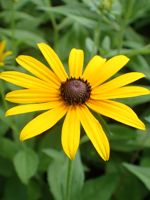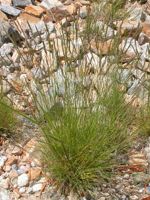Mon-Fri 9am - 5pm Mountain time
Black-Eyed Susan vs Idaho Fescue
Rudbeckia hirta
Festuca idahoensis
NOT AVAILABLE THIS SEASON - MIGHT RETURN
CUSTOM GROW
Black-Eyed Susan is a striking native wildflower known for its bright yellow, daisy-like flowers with dark center disks. With deadheading, the plant can bloom for an extended period, from mid-summer to early fall. These cheerful flowers attract a variety of pollinators, including bees and butterflies. Adding to its ecological value, the plant also acts as a host for the Wavy-Lined Emerald Moth (Synchlora aerata) and the Silvery Checkerspot (Chlosyne nycteis) butterfly.
While it is typically a short-lived perennial or biennial, the plant freely self-seeds. This allows it to persist in the landscape, particularly in natural areas where it can spread and establish itself. This plant is drought-tolerant, salt-tolerant, and deer and rabbit-resistant, making it ideal for challenging environments. The Black-Eyed Susan is well suited to wildflower gardens, pollinator gardens, as well as slopes, banks, and naturalized areas.
Idaho Fescue is a native perennial bunchgrass recognized for its fine-textured, blue-green foliage. Its dense, tufted growth and deep root system make it drought-tolerant and effective at stabilizing soils, particularly on slopes and open grasslands. Its upright, arching form and dense clumps give it strong ornamental value in both natural and designed landscapes.
This hardy grass provides cover for wildlife and forage for grazing animals, while also supporting soil health and habitat diversity. Idaho Fescue is well-suited for erosion control, ecological restoration, naturalization, xeriscaping, and habitat enhancement projects.

